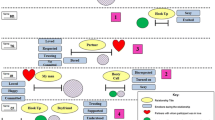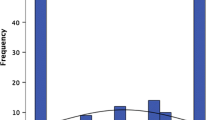Abstract
Gay and bisexual men are often treated as a homogenous group; however, there may be important differences between them. In addition, behaviorally bisexual men are a potential source of HIV infection for heterosexual women. In this study, we compared 97 men who have sex with men only (MSM) to 175 men who have sex with men and women (MSMW). We also compared the 175 MSMW to 772 men who have sex with women only (MSW). Bivariate and multiple logistic regression analyses were performed to assess correlates of MSMW risk behaviors with men and with women as well as whether MSMW, compared with MSW, engaged in more risky behaviors with women. Compared with MSM, MSMW were less likely to be HIV-positive or to engage in unprotected receptive anal intercourse. In contrast, MSMW were more likely than MSW to be HIV-positive and to engage in anal intercourse with their female partners; however, rates of unprotected anal intercourse were similar. The study findings suggest that there may be important differences in HIV risk behaviors and HIV prevalence between MSM and MSMW as well as between MSMW and MSW.
Similar content being viewed by others
References
Normand JL, Lambert EY, Vlahov D. Understanding the dynamics of sexual transmission of HIV among drug-using populations: an integration of biological, behavioral, and environmental perspectives. J Urban Health. 2003; 80(4 Suppl 3): iii1–6.
McFarland W, Katz MH, Stoyanoff SR, et al. HIV incidence among young men who have sex with men—seven U.S. cities, 1994–2000 (Reprinted from MMWR, 2001;50:440-444). JAMA. 2001; 286(3): 297–299.
Chu SY, Peterman TA, Doll LS, Buehler JW, Curran JW. AIDS in bisexual men in the United States: epidemiology and transmission to women. Am J Public Health. 1992; 82(2): 220–224.
Ekstrand ML, Coates TJ, Guydish JR, Hauck WW, Collette L, Hulley SB. Are bisexually identified men in San Francisco a common vector for spreading HIV infection to women? Am J Public Health. 1994; 84(6): 915–919.
Hightow LB, Leone PA, Macdonald PD, McCoy SI, Sampson LA, Kaplan AH. Men who have sex with men and women: a unique risk group for HIV transmission on North Carolina college campuses. Sex Transm Dis. 2006; 33(10): 585–593.
Montgomery JP, Mokotoff ED, Gentry AC, Blair JM. The extent of bisexual behaviour in HIV-infected men and implications for transmission to their female sex partners. AIDS Care. 2003; 15(6): 829–837.
O’Leary A, Jones KT. Bisexual men and heterosexual women: how big is the bridge? How can we know? Sex Transm Dis. 2006; 33(10): 594–595.
Kahn JG, Gurvey J, Pollack LM, Binson D, Catania JA. How many HIV infections cross the bisexual bridge? An estimate from the United States. AIDS. 1997; 11(8): 1031–1037.
Millett G, Malebranche D, Mason B, Spikes P. Focusing “down low”: bisexual black men, HIV risk and heterosexual transmission. J Natl Med Assoc. 2005; 97(7 Suppl): 52S–59S.
Doll LS, Beeker C. Male bisexual behavior and HIV risk in the United States: synthesis of research with implications for behavioral interventions. AIDS Educ Prev. 1996; 8(3): 205–225.
Kalichman SC, Roffman RA, Picciano JF, Bolan M. Risk for HIV infection among bisexual men seeking HIV-prevention services and risks posed to their female partners. Health Psychol. 1998; 17(4): 320–327.
Lichtenstein B. Secret encounters: black men, bisexuality, and AIDS in Alabama. Med Anthropol Q. 2000; 14(3): 374–393.
McKirnan DJ, Stokes JP, Doll L, Burzette RG. Bisexually active men: social characteristics and sexual behavior. J Sex Res. 1995; 32(1): 65–76.
Myers HF, Javanbakht M, Martinez M, Obediah S. Psychosocial predictors of risky sexual behaviors in African American men: implications for prevention. AIDS Educ Prev. 2003; 15(1 Suppl A): 66–79.
Stokes JP, McKirnan DJ, Doll L, Burzette RG. Female partners of bisexual men: what they don’t know might hurt them. Psychology of Women Quarterly. 1996; 20(2): 267–284.
Shehan DA, LaLota M, Johnson DF, et al. HIV/STD risks in young men who have sex with men who do not disclose their sexual orientation—six U.S. cities, 1994–2000. (Reprinted from MMWR. 2003;52:81–86,). JAMA. 2003; 289(8): 975–977.
Padian N, Marquis L, Francis DP, et al. Male-to-female transmission of human immunodeficiency virus. JAMA. 1987; 258(6): 788–790.
Powers KA, Poole C, Pettifor AE, Cohen MS. Rethinking the heterosexual infectivity of HIV-1: a systematic review and meta-analysis. Lancet Infect Dis. 2008; 8(9): 553–563.
Harawa NT, Williams JK, Ramamurthi HC, Bingham TA. Perceptions towards condom use, sexual activity, and HIV disclosure among HIV-positive African American men who have sex with men: implications for heterosexual transmission. J Urban Health. 2006; 83(4): 682–694.
Stall R, Paul JP, Greenwood G, et al. Alcohol use, drug use and alcohol-related problems among men who have sex with men: The Urban Men’s Health Study. Addiction. 2001; 96(11): 1589–1601.
Woody GE, VanEtten-Lee ML, McKirnan D, et al. Substance use among men who have sex with men: comparison with a national household survey. JAIDS. 2001; 27(1): 86–90.
Beckett M, Burnam A, Collins RL, Kanouse DE, Beckman R. Substance use and high-risk sex among people with HIV: a comparison across exposure groups. AIDS Behav. 2003; 7(2): 209–219.
Woody GE, Donnell D, Seage GR, et al. Non-injection substance use correlates with risky sex among men having sex with men: data from HIVNET. Drug Alcohol Depend. 1999; 53(3): 197–205.
Frosch D, Shoptaw S, Huber A, Rawson RA. Sexual HIV risk among gay and bisexual male methamphetamine abusers. J Subst Abuse Treat. 1996; 13(6): 483–486.
Dolezal C, Carballo-Diéguez A, Nieves-Rosa L, Díaz F. Substance use and sexual risk behavior: understanding their association among four ethnic groups of Latino men who have sex with men. J Subst Abuse. 2000; 11(4): 323–336.
Baseman J, Ross M, Williams M. Sale of sex for drugs and drugs for sex: an economic context of sexual risk behavior for STDs. Sex Transm Dis. 1999; 26(8): 444–449.
Latkin CA, Hua W, Forman VL. The relationship between social network characteristics and exchanging sex for drugs or money among drug users in Baltimore, MD, USA. Int J STD AIDS. 2003; 14(11): 770–775.
Weiser SD, Dilworth SE, Neilands TB, Cohen J, Bangsberg DR, Riley ED. Gender-specific correlates of sex trade among homeless and marginally housed individuals in San Francisco. J Urban Health. 2006; 83(4): 736–740.
Rietmeijer CA, Wolitski RJ, Fishbein M, Corby NH, Cohn DL. Sex hustling, injection drug use, and non-gay identification by men who have sex with men: associations with high-risk sexual behaviors and condom use. Sex Transm Dis. 1998; 25(7): 353–360.
Kuyper LM, Lampinen TM, Li K, et al. Factors associated with sex trade involvement among male participants in a prospective study of injection drug users. Sex Transm Infec. 2004; 80(6): 531–535.
Kral AH, Lorvick J, Ciccarone D, et al. HIV prevalence and risk behaviors among men who have sex with men and inject drugs in San Francisco. J Urban Health. 2005; 82(1 Suppl 1): i43–i50.
Newman PA, Rhodes F, Weiss RE. Correlates of sex trading among drug-using men who have sex with men. Am J Public Health. 2004; 94(11): 1998–2003.
El-Bassel N, Schillng RF, Gilbert L, Faruque S, Irwin KL, Edlin BR. Sex trading and psychological distress in a street-based sample of low-income urban men. J Psychoactive Drugs. 2000; 32(3): 259–267.
Weber AE, Craib KJ, Chan K, et al. Sex trade involvement and rates of human immunodeficiency virus positivity among young gay and bisexual men. Int J Epidemiol. 2001; 30(6): 1449–1454; discussion: 1455–1446.
Centers for Disease Control and Prevention. Methamphetamine use and HIV risk behaviors among heterosexual men—preliminary results from five northern California counties, December 2001–November 2003. MMWR. 2006; 55(10): 273–277.
Zule WA, Costenbader EC, Meyer WJ Jr, Wechsberg WM. Methamphetamine use and risky sexual behaviors during heterosexual encounters. Sex Transm Dis. 2007; 34(9): 689–694.
Zule WA, Desmond DP. An ethnographic comparison of HIV risk behaviors among heroin and methamphetamine injectors. Am J Drug Alcohol Abuse. 1999; 25(1): 1–23.
Siegel K, Schrimshaw EW, Lekas HM, Parsons JT. Sexual behaviors of non-gay identified non-disclosing men who have sex with men and women. Arch Sex Behav. 2008; 37(5): 720–735.
Adimora AA, Schoenbach VJ, Martinson FE, et al. Heterosexually transmitted HIV infection among African Americans in North Carolina. J Acquir Immune Defic Syndr. 2006; 41(5): 616–623.
Durant T, McDavid K, Hu X, Sullivan P, Janssen R, Fenton K. Racial/Ethnic disparities in diagnoses of HIV/AIDS—33 states, 2001–2005 (Reprinted from MMWR. 2006;56:189–193). JAMA. 2007; 297(15): 1647–1649.
Heckathorn DD. Respondent-driven sampling: a new approach to the study of hidden populations. Social Problems. 1997; 44(2): 174–199.
Heckathorn DD, Semaan S, Broadhead R, Hughes JJ. Extensions of respondent-driven sampling: a new approach to the study of injection drug users aged 18–25. AIDS Behav. 2002; 6(1): 55–67.
Iguchi MY, Ober AJ, Berry SH, et al. Simultaneous recruitment of drug users and men who have sex with men in the United States and Russia using respondent driven sampling: Sampling methods and implications. J Urban Health. 2009.
Metzger DS, Koblin B, Turner C, et al. Randomized controlled trial of audio computer-assisted self-interviewing: utility and acceptability in longitudinal studies. HIVNET Vaccine Preparedness Study Protocol Team. Am J Epidemiol. 2000; 152(2): 99–106.
Simoes AA, Bastos FI, Moreira RI, Lynch KG, Metzger DS. Acceptability of audio computer-assisted self-interview (ACASI) among substance abusers seeking treatment in Rio de Janeiro, Brazil. Drug Alcohol Depend. 2006; 82(Suppl 1): S103–S107.
Simoes AA, Bastos FI, Moreira RI, Lynch KG, Metzger DS. A randomized trial of audio computer and in-person interviewing to assess HIV risk among drug and alcohol users in Rio De Janeiro, Brazil. J Subst Abuse Treat. 2006; 30(3): 237–243.
Cepeda MS, Boston R, Farrar JT, Strom BL. Comparison of logistic regression versus propensity score when the number of events is low and there are multiple confounders. Am J Epidemiol. 2003; 158(3): 280–287.
D’Agostino RB. Propensity score methods for bias reduction in the comparison of a treatment to a non-randomized control group. Statistic in Medicine. 1998; 17(19): 2265–2281.
Rosenbaum PR, Rubin DB. Reducing bias in observational studies using subclassification on the propensity score. J Am Stat Assoc. 1984; 79(387): 516–524.
Sandfort TGM, Dodge B. “And then there was the Down Low”: introduction to Black and Latino male bisexualities. Arch Sex Behav. 2008; 37(5): 675–682.
Tillerson K. Explaining racial disparities in HIV/AIDS incidence among women in the U.S.: a systematic review. Statistics in Medicine. 2008; 27(20): 4132–4143.
Acknowledgments
This research is supported by grant no. U01da017373 from the National Institute on Drug Abuse (NIDA). The interpretations and conclusions do not necessarily represent the position of NIDA or the U.S. Department of health and human services.
Author information
Authors and Affiliations
Corresponding author
Additional information
RTI International is a trade name of Research Triangle Institute.
Rights and permissions
About this article
Cite this article
Zule, W.A., Bobashev, G.V., Wechsberg, W.M. et al. Behaviorally Bisexual Men and their Risk Behaviors with Men and Women. J Urban Health 86 (Suppl 1), 48–62 (2009). https://doi.org/10.1007/s11524-009-9366-3
Received:
Accepted:
Published:
Issue Date:
DOI: https://doi.org/10.1007/s11524-009-9366-3




